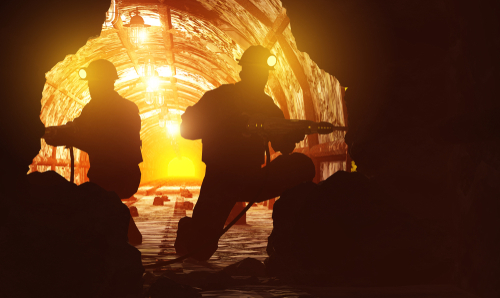Asbestos Exposure of Mine Workers
Mine workers often face significant asbestos exposure risks due to the natural presence of asbestos in various mineral deposits. During mining operations, asbestos fibers can be released into the air when disturbing asbestos-containing ore or rock. Inhalation of these fibers can lead to severe health issues over time.
Where Is Asbestos Found in the Mining Industry?
Mine workers may encounter asbestos in several common locations within their work environments, making understanding these areas crucial for safety:
- Asbestos Mines: The most direct source of exposure, asbestos mines involve extracting raw asbestos minerals. Workers in these mines are at the highest risk due to constant contact with asbestos fibers.
- Talc Mines: Talc deposits often contain asbestos fibers, particularly tremolite asbestos. When mining talc, workers may unknowingly release asbestos fibers into the air, increasing the risk of inhalation.
- Vermiculite Mines: Vermiculite deposits, such as those in Libby, Montana, are known to be contaminated with asbestos. Mining and processing vermiculite can disturb asbestos fibers, posing significant health risks to workers.
- Iron Ore and Gold Mines: Asbestos can be present in surrounding rock formations of iron ore and gold deposits. Mining activities in these areas can inadvertently release asbestos fibers, exposing workers to potential harm.
Asbestos Products Associated with Mining
 Mine workers can also encounter asbestos in the equipment and materials used during mining operations:
Mine workers can also encounter asbestos in the equipment and materials used during mining operations:
- Mining Equipment Insulation: Asbestos was commonly used to insulate machinery and equipment due to its heat-resistant properties. This insulation can deteriorate over time, releasing asbestos fibers into the air.
- Protective Clothing: Asbestos-containing clothing, such as gloves and aprons, provided protection against heat and chemical exposure. While effective, these garments also posed a risk of fiber release, especially when worn or handled.
- Building Materials: Asbestos was used extensively in the construction of mining facilities. Asbestos-containing cement, tiles, and insulation materials were common, and disturbing these materials during maintenance or renovation can release harmful fibers.
History of Asbestos in Mining
Asbestos mining and use peaked during the mid-20th century, driven by high demand across various industries. Asbestos’s durability and resistance to heat and chemicals made it a popular choice for many applications. Despite its popularity, the health risks associated with asbestos became increasingly apparent by the mid-20th century. Research linked asbestos exposure to serious diseases like mesothelioma, asbestosis, and lung cancer.
Starting in the 1970s, regulatory measures were introduced to protect workers and the public from asbestos exposure. In the United States, agencies like OSHA and the EPA implemented stringent regulations to limit asbestos use and ensure safer handling practices.
Despite these regulations, legacy asbestos exposures remain a concern. Workers in older mines or those handling historical asbestos deposits may still be at risk. Awareness and proper safety measures are crucial for protecting these workers from asbestos-related diseases.
Mine Workers and Mesothelioma
Mesothelioma is a rare cancer directly linked to asbestos exposure. Mine workers are at risk due to the nature of their work, which often involves disturbing asbestos-containing materials and releasing fibers into the air. Inhalation of these fibers can cause mesothelioma, asbestosis, and other severe lung conditions. The latency period for mesothelioma can be several decades, meaning symptoms may not appear until many years after exposure.
Symptoms of Asbestos-Related Diseases in Mine Workers
Recognizing the symptoms of asbestos-related diseases early is crucial for timely diagnosis and treatment. Mine workers exposed to asbestos may develop symptoms many years after the initial exposure. Common symptoms include:
- Shortness of Breath: Often a sign of lung issues, including asbestosis or mesothelioma.
- Persistent Cough: Can indicate lung irritation or early stages of asbestos-related diseases.
- Chest Pain: May be a symptom of pleural mesothelioma or lung cancer.
- Fatigue: Generalized tiredness or weakness, often associated with chronic illness.
- Unexplained Weight Loss: A common symptom of many cancers, including mesothelioma.
If you or a loved one experiences these symptoms, especially with a history of asbestos exposure, it is vital to consult a healthcare professional for evaluation and potential screening for asbestos-related conditions.
Preventive Measures and Safety Tips for Mine Workers
Given the ongoing risk of encountering asbestos in mines, mine workers should take proactive steps to protect themselves:
- Use Protective Equipment: Always wear appropriate personal protective equipment (PPE), such as masks and respirators, to minimize inhalation of asbestos fibers.
- Follow Safety Protocols: Adhere to safety guidelines and regulations for working with or around asbestos-containing materials.
- Identify Asbestos-Containing Materials: Learn to recognize materials and products that may contain asbestos. If you suspect asbestos, avoid disturbing the material and seek professional assessment.
- Stay Informed: Keep up to date with the latest regulations and safety practices related to asbestos in your industry.
- Seek Professional Training: Undergo asbestos awareness and handling training to understand the risks and proper safety procedures.
By following these safety measures, mine workers can significantly reduce their risk of asbestos exposure and protect their long-term health.
What To Do If You Were Exposed
If you suspect asbestos exposure, monitor your health closely and seek regular medical check-ups for symptoms like shortness of breath and persistent cough. Inform your doctor about your exposure history for appropriate screenings. Consult with a legal expert to explore your rights and potential compensation options for medical expenses and related costs.
Mine workers are at significant risk of asbestos exposure due to the natural presence of asbestos in many mineral deposits and the historical use of asbestos in mining equipment and facilities. Understanding the sources and risks of exposure is crucial for preventing health issues like mesothelioma. If you or a loved one has worked in the mining industry and has concerns about asbestos exposure, seek medical and legal advice to safeguard your health and rights.
